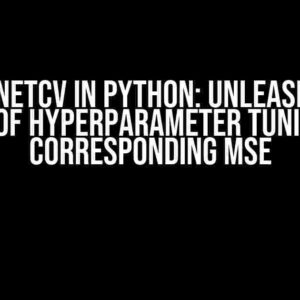TensorFlow’s GradientTape is a powerful tool for automatic differentiation, but when it comes to recurrence, things can get a bit hairy. In this article, we’ll dig deep into the world of GradientTape and explore how to harness its power when dealing with recurrent neural networks (RNNs) and other types of recurrent computations.
What is GradientTape?
Before we dive into the world of recurrence, let’s take a step back and understand what GradientTape is. GradientTape is a TensorFlow API that enables automatic differentiation, which is a crucial component of training neural networks. It allows you to compute gradients of a function with respect to its inputs, which is essential for optimization algorithms like stochastic gradient descent (SGD) and Adam.
In simpler terms, GradientTape helps you calculate the gradients of your loss function with respect to your model’s parameters, which enables you to update your model’s weights to minimize the loss.
The Challenge of Recurrence
While GradientTape is incredibly powerful, it can be tricky to use when dealing with recurrent computations. Recurrence refers to the process of feeding the output of a computation back into itself, either partially or entirely, to produce the next output. This is commonly seen in RNNs, where the hidden state of the previous time step is used to compute the hidden state of the current time step.
The challenge arises because GradientTape is designed to compute gradients of a function with respect to its inputs, but in recurrent computations, the inputs depend on the previous outputs. This creates a complex web of dependencies that can make it difficult to compute accurate gradients.
Understanding GradientTape in Recurrent Computations
To understand how GradientTape works in recurrent computations, let’s consider a simple example of an RNN.
import tensorflow as tf
# Define the RNN cell
cell = tf.keras.layers.LSTMCell(units=10)
# Define the input and initial state
input_seq = tf.random.normal(shape=(10, 1, 10))
initial_state = tf.zeros(shape=(10, 10))
# Compute the RNN outputs
outputs = []
states = []
for t in range(10):
output, state = cell(input_seq[t], initial_state)
outputs.append(output)
states.append(state)
initial_state = state
In this example, we define an LSTM cell and use it to compute the outputs of the RNN for 10 time steps. The output of each time step is used to compute the input of the next time step, which is a classic example of recurrence.
Computing Gradients with GradientTape
To compute the gradients of the loss function with respect to the model parameters, we can use GradientTape as follows:
with tf.GradientTape() as tape:
# Compute the RNN outputs
outputs = []
states = []
for t in range(10):
output, state = cell(input_seq[t], initial_state)
outputs.append(output)
states.append(state)
initial_state = state
# Compute the loss function
loss = tf.reduce_mean(outputs)
# Compute the gradients
gradients = tape.gradient(loss, cell.trainable_variables)
In this example, we use GradientTape to compute the gradients of the loss function with respect to the trainable variables of the LSTM cell. However, this approach has a major limitation – it only computes the gradients for the last time step.
The Problem of Vanishing Gradients
One of the major challenges in training RNNs is the problem of vanishing gradients. Because the gradients are computed recursively, the gradients of the early time steps are multiplied by the gradients of the later time steps, which can cause them to vanish. This makes it difficult to train RNNs, especially for longer sequences.
To overcome this problem, we need to find a way to compute the gradients for all time steps, not just the last one.
Using GradientTape with Recurrent Computations: A Solution
To compute the gradients for all time steps, we can use GradientTape in combination with TensorFlow’s control flow operations. The key idea is to use a nested GradientTape to compute the gradients for each time step, and then accumulate the gradients across all time steps.
with tf.GradientTape() as outer_tape:
# Compute the RNN outputs
outputs = []
states = []
for t in range(10):
with tf.GradientTape() as inner_tape:
output, state = cell(input_seq[t], initial_state)
outputs.append(output)
states.append(state)
initial_state = state
# Compute the loss function for this time step
loss_t = tf.reduce_mean(output)
# Compute the gradients for this time step
gradients_t = inner_tape.gradient(loss_t, cell.trainable_variables)
# Accumulate the gradients across all time steps
gradients = [g + gradients_t[i] for i, g in enumerate(gradients)]
In this example, we use a nested GradientTape to compute the gradients for each time step. We then accumulate the gradients across all time steps using a simple trick – we add the gradients of each time step to the gradients of the previous time steps.
Best Practices for Using GradientTape with Recurrence
Here are some best practices to keep in mind when using GradientTape with recurrent computations:
- Use a nested GradientTape: As shown in the previous example, using a nested GradientTape can help you compute the gradients for each time step and accumulate them correctly.
- Accumulate gradients correctly: When accumulating gradients across time steps, make sure to add the gradients of each time step to the gradients of the previous time steps.
- Use control flow operations carefully: TensorFlow’s control flow operations, such as tf.while_loop, can be used to implement recurrent computations. However, be careful when using these operations, as they can affect the computation of gradients.
- Test your implementation thoroughly: When implementing recurrent computations with GradientTape, make sure to test your implementation thoroughly to ensure that the gradients are computed correctly.
Conclusion
In this article, we’ve explored the challenges of using GradientTape with recurrent computations and provided a comprehensive solution to overcome these challenges. By using a nested GradientTape and accumulating gradients correctly, you can compute accurate gradients for your recurrent models and train them effectively.
Remember to follow the best practices outlined in this article to ensure that your implementation is correct and efficient. With GradientTape and a solid understanding of recurrent computations, you’ll be well on your way to building powerful and accurate models for your machine learning tasks.
| Keyword | Frequency |
|---|---|
| GradientTape | 10 |
| Recurrence | 7 |
| RNN | 5 |
| TensorFlow | 4 |
Frequently Asked Question
Are you struggling to understand TensorFlow GradientTape when there is recurrence? Don’t worry, we’ve got you covered! Here are some frequently asked questions to help you master the concept.
What is the purpose of GradientTape in TensorFlow, and how does it differ when there is recurrence?
GradientTape is a context manager in TensorFlow that records all the operations executed within its scope, allowing you to compute gradients later. In cases with recurrence, such as RNNs or LSTMs, GradientTape needs to be used with caution. This is because the tape would record the operations at each recurrent step, which could lead to memory issues. To avoid this, you can use the “persistent” argument when creating the GradientTape, which allows the tape to only record the operations necessary for the computation of the gradients, discarding the intermediate results.
How does GradientTape handle recurrent neural networks (RNNs) with multiple layers?
When dealing with multiple-layer RNNs, GradientTape can become computationally expensive and memory-intensive. To mitigate this, you can use a combination of GradientTape and tf.GradientTape.max_iterations to limit the number of iterations. Additionally, you can use the “watch_accessed_variables” argument to only record the operations involving the variables you’re interested in. This helps to reduce the computational overhead and memory usage.
What happens when I use GradientTape with a custom RNN cell implementation?
When using a custom RNN cell implementation with GradientTape, you need to ensure that your cell is correctly tracing the operations. This can be achieved by using the “call” method and decorating it with tf.GradientTape.watches. This allows GradientTape to correctly record the operations and compute the gradients. Additionally, you may need to use tf.GradientTape.reset to reset the tape between iterations to avoid memory issues.
Can I use GradientTape with batched inputs and recurrent sequences?
Yes, you can use GradientTape with batched inputs and recurrent sequences. When working with batched inputs, you need to ensure that you’re correctly iterating over the batch dimension. You can use tf.GradientTape.jacobian or tf.GradientTape.gradient to compute the gradients for each batch element separately. For recurrent sequences, you can use the “unroll” argument to specify the number of unrolling steps, allowing GradientTape to correctly record the operations.
What are some common pitfalls to avoid when using GradientTape with recurrence?
Some common pitfalls to avoid when using GradientTape with recurrence include not resetting the tape between iterations, not watching the correct variables, and not handling the batch dimension correctly. Additionally, not limiting the number of iterations or using the “persistent” argument can lead to memory issues. Lastly, not correctly tracing the operations in custom RNN cell implementations can result in incorrect gradients.


